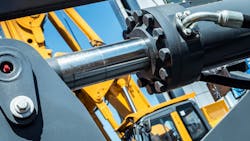4 Trends Shaping the Future of Hydraulic Fluids
What you’ll learn:
- Market factors necessitating continued hydraulic fluid development.
- Key industry trends that will shape future hydraulic oil formulations.
- The importance of balancing evolving market needs with performance requirements.
When most people think of hydraulic fluids, they think about what's happening inside the machine: keeping pressure stable, preventing wear, and running systems smoothly. But in the years ahead, what’s happening outside the machine may matter just as much.
Rising sustainability mandates, changing equipment designs, and higher expectations from end users are all reshaping how hydraulic fluids are developed, selected, and used.
While this transformation is gradual, its impact is significant. Based on Chevron’s experience in formulation science, field testing, and industry collaboration, we’ve identified four trends that we believe will shape hydraulic fluids over the next 5-10 years.
1. The Shift Toward Longer-Lasting Synthetic Fluids
The move toward synthetic fluids continues to gain traction, driven by a clear goal: make equipment last longer while reducing maintenance costs and environmental impact.
Synthetic hydraulic fluids offer greater durability and performance consistency over time compared to conventional mineral oils. They’re better equipped to handle extreme temperatures, high loads, and demanding duty cycles. For operators, this means fewer fluid changes, reduced maintenance interruptions, and improved uptime. For original equipment manufacturers (OEMs), it supports circular economy goals by extending the service life of equipment already in the field.
Improved durability not only keeps systems running longer between fluid changes, it also reduces waste and aligns with long-term sustainability goals. OEMs are designing machines to have more time in between service intervals, and fluids that meet those demands are becoming essential. In short, long-lasting performance is quickly becoming the new industry benchmark.
2. Hydraulic System Efficiency is Moving Into the Spotlight
Historically, hydraulic systems have delivered high power at the expense of efficiency. Many systems operate at just 10-20% efficiency, with energy lost to internal leakage, pressure drop, and friction. However, that’s changing.
There’s a growing recognition that the fluid itself plays a key role in system efficiency and productivity. Through years of bench and field testing, our teams have demonstrated measurable gains in energy transfer and system responsiveness when using advanced synthetic fluids designed with efficiency in mind.
As the industry places greater emphasis on reducing carbon footprints and maximizing performance per kilowatt-hour, hydraulic fluids that reduce internal friction, minimize pressure losses, and improve volumetric efficiency will become increasingly vital. Efficiency is no longer just a design challenge for components, it’s a formulation challenge for fluids, too.
3. Electrification and Compact Systems Will Change the Game for Hydraulic Fluids
Electrification isn’t limited to passenger vehicles, it’s transforming heavy-duty mobile equipment, stationary systems, and even hydraulics. As electric and hybrid equipment emerge across construction, manufacturing, and material handling, we expect to see more compact and specialized hydraulic systems follow.
This shift introduces new requirements for hydraulic fluids. Smaller fluid volumes mean less tolerance for contamination or degradation, while longer operating intervals demand greater oxidative stability.
In some cases, we foresee a shift toward “fill-for-life” hydraulic fluids: low-volume systems optimized for specific operational tasks and sealed for long-term use. These systems will require fluids with exceptional stability, cleanliness, and resistance to degradation over time. That means tomorrow’s fluids won’t just need to perform well at startup, but also maintain those properties over years of continuous operation in electrified platforms.
4. Zinc-Free Hydraulic Fluid Formulations are the Future
Zinc-based and zinc-free hydraulic fluids have coexisted in the market for years. Zinc-based fluids have dominated due to strong pump performance and lower cost.
However, zinc-free technology has advanced significantly, now meeting strict pump test standards while offering better deposit control, higher oxidation resistance (especially in the presence of water), and reduced environmental impact.
These benefits can lead to lower maintenance costs and improved system reliability for end users. As a result, the cost gap between zinc-based and zinc-free fluids is expected to narrow, making zinc-free formulations a more attractive long-term solution.
Learn more about some of the trends influencing hydraulic fluid and lubricant designs in the below content.
Future Hydraulic Oils Must Balance Performance and Compliance
Each of these trends ties back to a fundamental challenge: bridging the gap between environmental compliance and operational performance. In the past, hydraulic fluids that met strict biodegradability or toxicity requirements often came with trade-offs. They broke down faster, reduced hydrolytic stability, or failed to meet standard performance benchmarks like filterability or oxidation resistance.
Those compromises are no longer acceptable. New technologies are emerging that close the performance gap between environmentally acceptable fluids and conventional mineral-based products. The bar is rising not only in laboratory specs but in real-world applications where the field demands both regulatory compliance and operational resilience.
In some regions, regulations now require companies to calculate the full lifecycle carbon impact of the fluids they use, from raw material sourcing through production and application. At the same time, procurement teams are evaluating not just technical spec sheets, but sustainability claims that hold up under scrutiny.
In this environment, it’s not enough for a hydraulic fluid to meet a biodegradability threshold. It must do so without forcing operators to shorten maintenance intervals, change fluids more frequently, or accept diminished system protection.
Companies that want to stay competitive can’t afford to treat hydraulic fluid as an afterthought. Choosing the right formulation is becoming a strategic decision with implications for equipment uptime, carbon footprint, and even the ability to bid on certain projects.
Our advice? Don’t wait for the market to force change. Start evaluating fluid performance through the lens of efficiency, sustainability, and system compatibility. Invest in field testing and data collection that can demonstrate real-world value. And perhaps most importantly, don’t be afraid to take the risk of adopting new fluid technologies. Success in the next era of hydraulics will depend on forward-thinking formulation today.
This article was written and contributed by Max Cundiff, Industrial Sector Manager at Chevron.
About the Author
Max Cundiff
Industrial Sector Manager, Chevron
Max Cundiff is the Industrial Sector Manager at Chevron, where he brings more than a decade of experience within the oil and gas industry. With a background spanning customer relationship management, international business, and strategic growth initiatives, he is dedicated to helping customers improve performance while advancing Chevron’s industrial market presence. Max holds both a BS in Business Administration and an MBA with an emphasis in Entrepreneurship from the University of Louisville.

Leaders relevant to this article:





